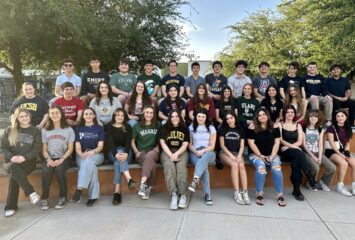Pardes Students Uncover the Mysteries of Ancient Egypt
January 14 – On a recent trip to the Ancient Egypt Museum, visitors were captivated by the many historical exhibits that brought this ancient culture to life. Guests stepped back into time as they entered an ancient sarcophagus, watched demonstrations of how Shadufi (ancient irrigation devices used to collect water) worked and learned about the origins of Egyptian Mythology. Docents were on hand to share facts, artifacts and details of what life was like during this unique period.
But this was no ordinary museum. The Ancient Egypt Museum was entirely planned, created and staffed by Pardes Jewish Day Schools fifth grade students. At each exhibit, the museum’s docents shared intriguing details on everything from the Egyptian pyramids, mummification and hieroglyphics to Egyptian fashion and how papyrus was made.
“The board game Senet, a favorite pastime of the Egyptians is the oldest game that’s still being played today”, shared Jadon Waldof and Indigo Ehrlich. An elaborate version of the game was discovered in Tutankhamen’s tomb. They also pointed out that the game “ jacks” was originally called knuckle bones and was made from sheep ankle bones.
Docents Eliza Kreitzman and Samantha Daitch describe the main types of Egyptian masks. Death masks, they explained, covered the faces of the dead. They helped souls recognize and return to their bodies so the deceased could go to the after life. Masks for royalty were made of precious metals like gold. Funerary masks for those with less money were make of materials like linen, molded to the face and highly decorated. Tutankhamen’s is the most famous death mask. Ritual masks were worn by priests for ritual ceremonies.
At another exhibit, visitors learned there were sometimes up to six tombs for a Pharaoh. One was for the Pharaoh himself while another contained canopic jars safekeeping his organs. Additional tombs might contain the Pharaoh’s clothes, a beloved pet who was killed and mummified in order to follow his master into the afterlife, plus one or two tombs for the Pharaoh’s favorite things like wine goblets and other prized possessions.
The breadth and depth of the information the students presented was another notable example of how the school combines Project Based Learning with 21st Century Learning to create the next generation of learners, leaders, and innovators.



